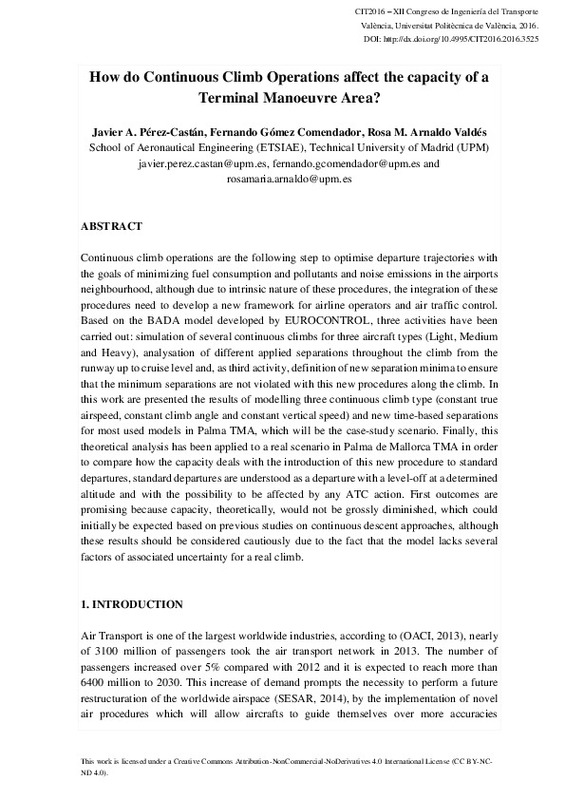JavaScript is disabled for your browser. Some features of this site may not work without it.
Buscar en RiuNet
Listar
Mi cuenta
Estadísticas
Ayuda RiuNet
Admin. UPV
How do Continuous Climb Operations affect the capacity of a Terminal Manoeuvre Area?
Mostrar el registro sencillo del ítem
Ficheros en el ítem
| dc.contributor.author | Pérez Castán, Javier
|
es_ES |
| dc.contributor.author | Gómez Comendador, Fernando
|
es_ES |
| dc.contributor.author | Arnaldo Valdés, Rosa M.
|
es_ES |
| dc.coverage.spatial | east=2.736164899999949; north=39.5517407; name=Aeroport de Palma (PMI), 07611 Palma, Illes Balears, Espanya | |
| dc.date.accessioned | 2017-11-03T08:51:12Z | |
| dc.date.available | 2017-11-03T08:51:12Z | |
| dc.date.issued | 2016-06-01 | |
| dc.identifier.isbn | 9788460899600 | |
| dc.identifier.uri | http://hdl.handle.net/10251/90368 | |
| dc.description.abstract | [EN] Continuous climb operations are the following step to optimise departure trajectories with the goals of minimizing fuel consumption and pollutants and noise emissions in the airports neighbourhood, although due to intrinsic nature of these procedures, the integration of these procedures need to develop a new framework for airline operators and air traffic control. Based on the BADA model developed by EUROCONTROL, three activities have been carried out: simulation of several continuous climbs for three aircraft types (Light, Medium and Heavy), analysation of different applied separations throughout the climb from the runway up to cruise level and, as third activity, definition of new separation minima to ensure that the minimum separations are not violated with this new procedures along the climb. In this work are presented the results of modelling three continuous climb type (constant true airspeed, constant climb angle and constant vertical speed) and new time-based separations for most used models in Palma TMA, which will be the case-study scenario. Finally, this theoretical analysis has been applied to a real scenario in Palma de Mallorca TMA in order to compare how the capacity deals with the introduction of this new procedure to standard departures, standard departures are understood as a departure with a level-off at a determined altitude and with the possibility to be affected by any ATC action. First outcomes are promising because capacity, theoretically, would not be grossly diminished, which could initially be expected based on previous studies on continuous descent approaches, although these results should be considered cautiously due to the fact that the model lacks several factors of associated uncertainty for a real climb. | es_ES |
| dc.description.sponsorship | This Project has been developed under the programe “Plan estatal de Innovación Científica y Técnica y de Innovación 2013-2016, Programa Estatal de Investigación, Desarrollo e Innovación Orientada a los Retos de la Sociedad: Development and optimization of takeoff and climb procedures for a smarter, sustainable and integrated air transport air transport system” with the collaboration of the Rey Juan Carlos University. | |
| dc.format.extent | 8 | es_ES |
| dc.language | Inglés | es_ES |
| dc.publisher | Editorial Universitat Politècnica de València | es_ES |
| dc.relation.ispartof | XII Congreso de ingeniería del transporte. 7, 8 y 9 de Junio, Valencia (España) | es_ES |
| dc.rights | Reconocimiento - No comercial - Sin obra derivada (by-nc-nd) | es_ES |
| dc.subject | Continuous Climb Operation | es_ES |
| dc.subject | Trajectory optimisation | es_ES |
| dc.subject | Air Traffic Management | es_ES |
| dc.title | How do Continuous Climb Operations affect the capacity of a Terminal Manoeuvre Area? | es_ES |
| dc.type | Capítulo de libro | es_ES |
| dc.type | Comunicación en congreso | es_ES |
| dc.identifier.doi | 10.4995/CIT2016.2015.3525 | |
| dc.rights.accessRights | Abierto | es_ES |
| dc.description.bibliographicCitation | Pérez Castán, J.; Gómez Comendador, F.; Arnaldo Valdés, RM. (2016). How do Continuous Climb Operations affect the capacity of a Terminal Manoeuvre Area?. En XII Congreso de ingeniería del transporte. 7, 8 y 9 de Junio, Valencia (España). Editorial Universitat Politècnica de València. 113-120. https://doi.org/10.4995/CIT2016.2015.3525 | es_ES |
| dc.description.accrualMethod | OCS | es_ES |
| dc.relation.conferencename | CIT2016. Congreso de Ingeniería del Transporte | es_ES |
| dc.relation.conferencedate | June 07-09,2016 | es_ES |
| dc.relation.conferenceplace | Valencia, Spain | es_ES |
| dc.relation.publisherversion | http://ocs.editorial.upv.es/index.php/CIT/CIT2016/paper/view/3525 | es_ES |
| dc.description.upvformatpinicio | 113 | es_ES |
| dc.description.upvformatpfin | 120 | es_ES |
| dc.type.version | info:eu-repo/semantics/publishedVersion | es_ES |
| dc.relation.pasarela | OCS\3525 | es_ES |
| dc.contributor.funder | Ministerio de Ciencia e Innovación | |
| dc.contributor.funder | Universidad Carlos III de Madrid |








